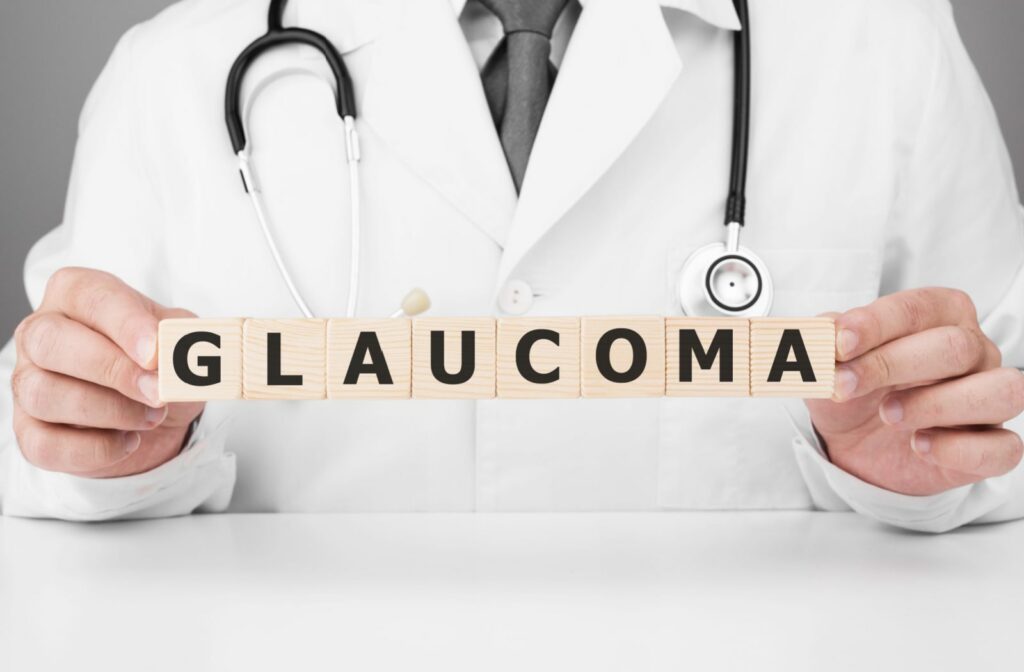Glaucoma is an eye condition that can cause permanent vision loss. Unfortunately, glaucoma is also a slow-developing condition that can lie undetected until it causes changes to your vision.
Glaucoma often has no noticeable symptoms during its early stages, but the first signs of glaucoma as it progresses can include peripheral vision loss, blurry vision, and eye pain. With regular eye exams and early detection of glaucoma, you can protect your sight.
What Is Glaucoma?
Glaucoma is not just one eye disease but rather a group of eye disorders characterized by damage to the optic nerve. It affects more than 450,000 Canadians and is a leading cause of blindness.
Your optic nerve connects your retina (the light-sensitive tissue at the back of your eye) to your brain, which is how we see the world around us. Damage to your optic nerve can result in irreversible vision loss.
What Causes Glaucoma?
Damage to the optic nerve often occurs due to fluid buildup that increases the pressure within the eye, known as intraocular pressure (IOP). The exact causes of glaucoma aren’t exactly clear, but risk factors for glaucoma can include the following:
- Genetics
- Age
- A family history of glaucoma
- High fluid pressure inside the eyes
- Decreased corneal thickness
Types of Glaucoma
There are several types of glaucoma, including the following:
- Open-angle glaucoma is the most common form of glaucoma and can cause irreversible vision loss that usually becomes apparent after the disease has progressed. Open-angle glaucoma is typically caused by increased eye pressure.
- Normal tension glaucoma occurs from damage to the optic nerve in situations where your eye pressure is normal.
- Angle-closure glaucoma is an eye emergency that can develop when drainage systems in your eye are blocked and lead to fluid buildup. It can occur suddenly, and without prompt treatment, you can lose sight within a day.
First Signs of Glaucoma
Imagine a world without visual clarity. Gradual vision loss is a reality many people face due to glaucoma. Because glaucoma can sneak up on you without warning, gradually robbing you of your vision, it’s often called the ‘silent thief of sight.’
It’s important to remember that glaucoma often has no noticeable early symptoms—but it can be detected early during an eye exam. The symptoms that develop as the disease progresses can depend on the type of glaucoma you have but may include some or all of the following issues.
Peripheral Vision Loss
One of the first signs of glaucoma is peripheral vision loss, which is the outermost area of your sight. You may not notice vision loss until it becomes more advanced.
Individuals with glaucoma often report blind spots or difficulty seeing objects or people in the side of their visual field. Over time, this tunnel vision effect can worsen.
Blurred Vision
Blurred vision can be an early indicator of glaucoma. Blurriness often occurs because glaucoma damages the optic nerve responsible for transmitting visual information to the brain. As the nerve deteriorates, the brain struggles to process images correctly, resulting in blurry vision.
Halos Around Lights
Seeing halos around lights, especially at night, can be another early sign of glaucoma. Halos may occur because increased intraocular pressure can cause light to scatter as it enters the eye. When this happens, you may notice bright circles or halos around light sources, making nighttime driving and other activities more challenging.
Other Symptoms
Angle-closure glaucoma is often associated with a sudden onset of severe symptoms, including:
- Eye redness
- Eye pain
- Nausea
- Vomiting
- Headaches
Some symptoms of glaucoma, such as blurry vision, eye pain, and redness, can resemble other eye conditions, such as dry eye disease or cataracts. If you experience any changes to your vision, you should visit your eye doctor to determine the underlying cause.
Glaucoma Treatment
While elevated intraocular pressure is not typically a symptom you can feel, it is a significant risk factor for glaucoma. Regular eye exams are crucial because they help detect increased intraocular pressure before it causes any noticeable problems.
There is no cure for glaucoma. However, treatment can help lower intraocular pressure to prevent further damage to the optic nerve.
Some of the treatment options for glaucoma include:
- Medication: Non-invasive forms of treatment can include the use of eye drops. These medications help reduce elevated eye pressure so fluid can drain from the eyes, or cause the eyes to produce less fluid.
- Drainage implants: Small silicone tubes inserted in the eye can help excess fluid drain from the eyes to prevent high eye pressure.
- Laser surgery: When medication isn’t enough to help lower eye pressure, your eye doctor may recommend laser surgery procedures that involve using a laser to create a new opening or a drainage flap in your eye.
You Can Catch Glaucoma Early
Glaucoma is a serious eye condition, but the first signs can be subtle and easily dismissed. Remember, early detection is key when it comes to treating glaucoma. Routine, comprehensive eye exams can help you identify and treat glaucoma before it affects your vision.
If you experience any of the symptoms mentioned above or notice changes in your vision, book an appointment with Advance Eye Care Center. With swift action and the right treatment plan, you can preserve your sight and prevent further vision loss.





